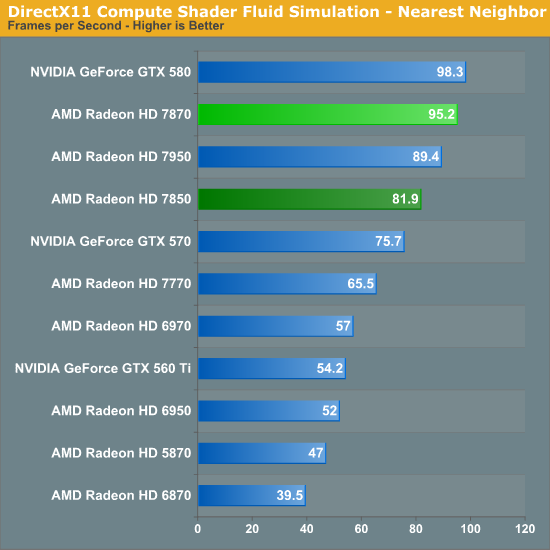AMD Radeon HD 7870 GHz Edition & Radeon HD 7850 Review: Rounding Out Southern Islands
by Ryan Smith on March 5, 2012 12:01 AM ESTCompute Performance
Moving on from our look at gaming performance, we have our customary look at compute performance. With GCN AMD significantly overhauled their architecture in order to improve compute performance, as their long-run initiatives rely on GPU compute performance becoming far more important than it is today.
Our first compute benchmark comes from Civilization V, which uses DirectCompute to decompress textures on the fly. Civ V includes a sub-benchmark that exclusively tests the speed of their texture decompression algorithm by repeatedly decompressing the textures required for one of the game’s leader scenes. Note that this is a DX11 DirectCompute benchmark.

The Civ V compute shader benchmark once again shows off just how much the compute shader performance of the 7800 series has improved relative to the 6900 series, with both 7800 cards coming in well, well ahead of any previous generation AMD cards. Compared to NVIDIA’s lineup the 7800 series does fairly well for itself too, although not quite as well as the commanding lead the 7900 series took.
Our next benchmark is SmallLuxGPU, the GPU ray tracing branch of the open source LuxRender renderer. We’re now using a development build from the version 2.0 branch, and we’ve moved on to a more complex scene that hopefully will provide a greater challenge to our GPUs.

SmallLuxGPU continues to showcase the 7800 series’ improvements over past AMD architectures, and while it’s not the same kind of massive leap we saw with CivV, it’s still enough to bring the 7850 up to near the performance of the 6970, and pushing the 7870 well beyond that. The only real competition here for AMD is AMD.
For our next benchmark we’re looking at AESEncryptDecrypt, an OpenCL AES encryption routine that AES encrypts/decrypts an 8K x 8K pixel square image file. The results of this benchmark are the average time to encrypt the image over a number of iterations of the AES cypher.

On the one hand, the 7870 gets quite close to the 7950 here in our AESEncryptDecrypt benchmark, in spite of the latter’s higher number of shaders. On the other hand, it’s still not enough to dethrone the GTX 570; the only NVIDIA cards the 7800 series can beat start at the GTX 560 Ti.
Finally, our last benchmark is once again looking at compute shader performance, this time through the Fluid simulation sample in the DirectX SDK. This program simulates the motion and interactions of a 16k particle fluid using a compute shader, with a choice of several different algorithms. In this case we’re using an (O)n^2 nearest neighbor method that is optimized by using shared memory to cache data.

In our final compute test the 7800 series once again makes a run at the top, with both cards rising past the GTX 570, although they can’t quite match the GTX 580. In an interesting turn of events the 7870 ends up being some 6% faster than the 7950, in spite of the fact that in a compute benchmark the 7950 should have a solid lead. This just goes to show that core clockspeeds do matter, and that adding more shaders alone can’t conquer all benchmarks.










173 Comments
View All Comments
medi01 - Monday, March 5, 2012 - link
AMD released cards that are better than competitors in all areas: pricing, power consumption, performance, yet he found a way to be "dissapointed"You can't reason with fanboi.
Kiste - Monday, March 5, 2012 - link
You're the one who seems obsessed with which company releases the "better cards".I'm merely commenting on the 78xx line of cards, which I find underwhelming in terms of price/performance ration - and I am not alone wiht this if you bothered reading the other comments here.
So who's the fanboy?
formulav8 - Monday, March 5, 2012 - link
You are. Your annoying as well.chizow - Monday, March 5, 2012 - link
Try laying off the personal attacks and focus on the arguments instead.I don't see how anyone can defend the pricing of AMD's 7 series stack in good conscience though, if roles were reversed and Nvidia were the one doing this, EVERYONE would be disappointed too I'm sure.
Kaboose - Monday, March 5, 2012 - link
wasn't it everyone who said the 6000 series was too expensive back in october of 2010 and when Nvidia released the 500 series prices would come down a lot, then Nvidia released the 500 series right in between what AMD had and neither company really lowered prices for months. I think we will keep seeing more of that when the 600 series is released. This way BOTH companies profit.chizow - Monday, March 5, 2012 - link
Not sure what you're referring to, Nvidia launched GTX 570/580 before AMD launched the 6-series.And no Nvidia didn't raise prices on their 470/480 at the time which were at the same price points even though the 500 series extended that lead.
AMD priced the 6000 series accordingly, and I don't recall anyone complaining other than being disappointed it didn't offer more performance.
SlyNine - Monday, March 5, 2012 - link
5870 user here. What everyone defending the 7xxx node change doesn't consider that most of us dissopointed in SI are compairing it to other fab shrinks.Iketh - Monday, March 5, 2012 - link
You're on nvidia's payroll. Get off this site.sseemaku - Monday, March 5, 2012 - link
Are engineers in nvidia thinking in the same way and not releasing their cards! Good for AMD.medi01 - Monday, March 5, 2012 - link
7850 outperforms 570 while costing 80$ less.nFanboi much?